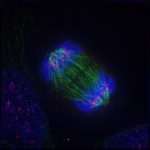Definition
noun
The collective term for all the spindle fibers that form during mitosis
Supplement
The spindle apparatus is the collective term for all the spindle fibers that form during mitosis or meiosis. These spindle fibers are responsible in moving and segregating the chromosomes during nuclear division. The spindle apparatus that forms during mitosis is referred to as mitotic spindle whereas the one that forms during meiosis is called meiotic spindle.
Spindle fibers are made up of microtubules and they appear as spindle-shaped structures (thus, the name). They develop outside the nucleus during mitosis. The major components of the mitotic spindle include the spindle fibers (microtubules), microtubule-associated proteins, and the microtubule organizing center. The microtubules associated with mitosis are of three groups: the polar microtubules, the astral microtubules, and the kinetochore microtubules. The polar microtubules are those that extend across the cell, i.e. from centrosome to centrosome. The astral microtubules are those that anchor the spindle poles to the cell membrane. The kinetochore microtubules are those that extend from the centrosome to the kinetochore protein in the centromere of the chromosome.
The spindle fibers first appear particularly during prophase. In metaphase, they facilitate in aligning the chromosomes to the metaphase plate. In anaphase, the spindle fibers pull the chromatids apart toward opposite poles.
Synonym(s):
- mitotic apparatus
- nuclear spindle
See also:

